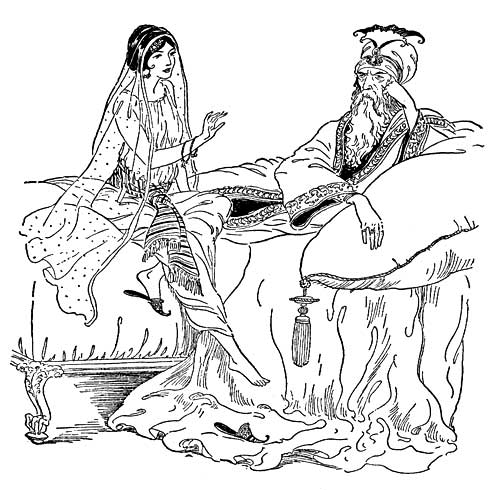
(Wikimedia Commons public domain image)
One typical feature of the Nights is the use of the “frame story technique,” in which a character in one story will say something along the lines of “Beware, lest there befall you that which happened to A.” Another character will respond curiously, “And what was that?” at which point the first speaker tells the story of A. And perhaps, in that story, a character may ask “Do you not recall the story of B?” Whereupon another character will say “And what story was that?” thus inviting the telling of that tale.
Thus a story is nested within a story, and oftimes another story is nested within that one, and perhaps yet another story within the third one. Sometimes there will be several levels of embedding, rather like a Russian matryoshka or babushka doll.[1] A reader can easily become so completely absorbed by the latest story that, when she suddenly emerges from that one back to another tale in which she had previously been thoroughly engrossed, it can be quite a surprise.
The technique of the “frame story” was already known in ancient Egypt, where it occurs in the Papyrus Westcar (P. Berlin 3033) and in the Tale of the Shipwrecked Sailor and The Eloquent Peasant. It also appears in early Sanskrit literature in India, including such epics as the Mahabharata and the Ramayana, and in the collection of animal fables known as the Panchatantra.
In the Nights, the main, overall frame story is that King Shahryār and his (latest) wife, Shahrazād, who is more widely known in the West as Scheherazade (not least through the marvelous 1888 symphonic suite of that same name, Op. 35, by Nikolai Rimsky-Korsakov). Shocked at that adulterous behavior of his brother’s wife and then betrayed by his own, the king has essentially vowed war against women, marrying a new virgin every night and killing her at dawn. Appalled by the slaughter and determined to stop it, Scheherazade, the learned, witty, and resourceful daughter of the royal vizier—effectively, the kingdom’s prime minister—volunteers to marry the king. Her plan, which ultimately succeeds, is to tell wonderful stories to the monarch, her husband, that are always timed to be incomplete at sunrise. So Shahryār spares her for another night until, after several children have been born to them, he abandons his murderous intention. But this, of course, becomes the vehicle that allows plenty of narrative opportunity for the retelling of numerous wonderful tales. We’re talking, after all, about a thousand and one nights.
[1] https://en.wikipedia.org/wiki/Matryoshka_doll
Posted from Canmore, Alberta, Canada











